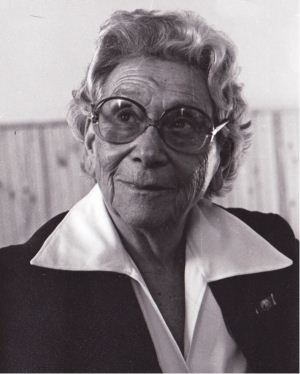
Beginnings
As Dr. Emmi Pikler (1902-1984), a Hungarian paediatrician, strolled along a beach in Italy in the early 1930s, she paused to watch the other families scattered around her. As a young mother herself, Emmi was particularly attentive to how parents were interacting with their little toddlers. As expected, most of them were busy getting their little ones to sit up or stand, propping them up, or helping them walk from one doting parent to another, laughing, cajoling, and pushing them to “learn” more grown-up actions. It was obvious to Emmi that the children clearly weren’t at a stage where they could do these things yet. Would that mean, she wondered, that the children were already being told they weren’t good enough?
She and her husband, a mathematics teacher, had already decided that Anna, their little daughter, would never be pushed into doing something she wasn’t already doing on her own. This idea, backed by their own observations, was simple, yet ground-breaking: let children develop at their own pace and in their own space; they’ll emerge healthier, more adept, and more capable of negotiating what lies ahead.
The seed for this idea could also be traced back to Emmi’s time as a medical student. While studying in Vienna, Emmi had observed that fractures and concussions were far less frequent in children from modest backgrounds, the ones who were allowed to run around the streets on their own, to roam, fall, pick themselves up and carry on. More well-to-do families, on the other hand, tended to be more careful, both in terms of limiting free-play, as well as guiding their children and “helping” them through the accepted developmental stages. Both these experiences would have a long-standing impact on Emmi and help her in developing the Pikler Approach.
Lóczy
After setting up a private paediatric practice in Budapest, Emmi further developed her ideas with the help of a host of other like-minded teachers and medical practitioners. She and her family escaped persecution during the Second World War thanks to the efforts of the families she was working with, and emerged safely from the devastation all around Europe. With so many children left vulnerable and helpless after the war, Emmi was asked to start a residential nursery in Budapest to help war-affected families.
Lóczy, as the home came to be known, became a centre for refining her ideas in a real-world setting that allowed for detailed investigation. It was at this orphanage, which has housed over 2000 children since its inception, that the Pikler Approach was consolidated with solid data and research to back it up.
Key Principles
So, what does the Pikler approach mean for us today? In simple words: pace, space, and care.
Letting children develop at their own pace is a key concept of the Pikler approach. When children are forced to do things they aren’t ready to do yet, we unknowingly hamper their true development. If a toddler can stand up, he will. Similarly, if your little one is ready to begin climbing, there’s little you can do to stop her. When we “teach” our babies to do this we are denying them the opportunity to learn on their own, according to Pikler.
When children learn to sit or walk or climb or run on their own, they aren’t only learning these motor skills but also picking up the skill of how to learn. If we try to assist them at every step we stop them from doing something essential -- being independent while learning about their boundaries. A child will simply do things when she is ready to do them, and at the same time learn and refine their fine and gross motor skills as well as cognitive abilities.
Giving children the space to learn is just as crucial. While it will be some time before your toddler can be allowed to run around in a park or play with friends unsupervised, it’s crucial to give him the opportunity to do so in an enriched environment at home. Toys that cultivate and encourage free and adventurous play are critical for this. The Pikler Triangle, for example, is a perfect entry to the world of free play for any child. Whether it’s a teeny one grasping onto its bars as she stands up for the first time, or a more adventurous five-year-old climbing right up to the top, the Pikler Triangle evolves with the evolution of the child’s abilities and skills. By providing a flexible base feeding into myriad opportunities this toy epitomises the Pikler Approach.
All of this must happen with the development of a caring relationship with the child. Every child must be given the chance to develop at their own pace and within a safe space while being given the care that they need from their guardians. By respecting the child and where she is in terms of her development, we provide her with ample opportunity to grow and learn all the essential skills she must pick up at this crucial stage. To respect a child we must let her learn who she is, push herself, or wait another day to do so. We are there by our toddler’s side but we trust him enough to do what he wants at a particular time, never forcing his hand.
The seeds for the Pikler Approach were planted almost a hundred years ago, yet their essence continues to act as a beacon for all parents even today. So, the next time you have your little angelic devil by your side, remember all she needs from you is respect for pace, space, and a whole lot of care.
Further reading:
https://thepiklercollection.weebly.com/
This article is part of a series on adventurous play. Have a look at our Bloon Pikler Collection -
Inspired by Dr. Emmi Pikler’s Pikler Triangle - the Bloon Pikler brings to you a versatile and adaptable range of climbing frames and accessories designed to see a growing child through all their stages of development - giving them different levels of challenge, adventure, physical and imaginative play... playful furniture they never grow out of!



Leave a comment